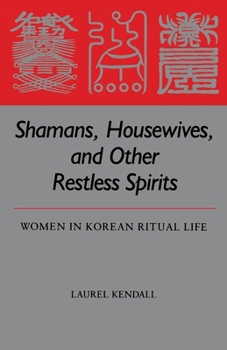Shamans, Housewives, and Other Restless Spirits: Women in Korean Ritual Life
(Part of the Studies of the Weatherhead East Asian Institute, Columbia University Series)
Select Format
Select Condition 
Book Overview
"This exceptionally well-written book is good reading, not only for specialists but also for beginning students interested in women, Korean culture, and shamanism." --Journal of Asian Studies
Format:Paperback
Language:English
ISBN:0824811429
ISBN13:9780824811426
Release Date:July 1987
Publisher:University of Hawaii Press
Length:248 Pages
Weight:0.68 lbs.
Dimensions:0.6" x 5.5" x 8.3"
Customer Reviews
3 ratings
Readable Introduction to this woman-centered Korean Folk religion
Published by Thriftbooks.com User , 15 years ago
This book gives the most thorough introduction to this female-centered folk religion available in English, and it provides important information necessary for all those interested in the structure of the Korean family, or the place of women and their ceremonies in Korean social life. " **** CONTENTS: * Preface 1 - A 'Kut' for the Chon Family 2 - Confucian Patriarchs and Spirited Women 3 - Enduring Pine Village 4 - Divine Connections: The 'Mansin' and her Clients 5 - Wood Imps, Ghosts, and Other Noxious Influences 6 - The Care and Feeding of Household Gods and Kindered Spirits 7 - The Care and Feeding of Ancestors 8 - Women's Rites Appendixes: 1 - The Chon Family 'Kut' 2 - Major Concerns Expressed in Divination Sessions 3 - Ancestors Appearing in 'Kut'
the best first book on Korean "shamanism"
Published by Thriftbooks.com User , 18 years ago
Korean shamanism played a crucial role in traditional village religion, and the concepts and assumptions embodied in it are still present in Korean culture. Yet the village traditions have been disappearing, or at least rapidly changing, in modern Korea. Kendall's thesis is that if you really want to understand Korean religion, shamanism is essential. Traditional scholars (influenced partly by Confucianism and partly by a "scientific" disdain for "superstition") emphasized Buddhism and Confucianism, with Christianity appearing and thriving in recent times. Shamanism and women's religious traditions were considered unimportant to the "official" religion of Korea. But Kendall argues successfully that actually the various traditions (not counting Christianity) are/were complementary in practice; the women's rituals dealt with some issues, the men's with others. Underlying the discussion is the issue of women's traditional roles in Korea, which were frankly oppressive, and yet as Kendall reveals, of course the women were not entirely powerless. Kendall argues that women's roles complemented men's roles, implying (Kendall doesn't say so explicitly) that traditional accounts have overemphasized women's formal inferiority at the expense of an accurate understanding of the reality of everyday life and religion. Anyway, this book is a very good introduction to the shamanist tradition in Korea--not so much an overview, but an introduction. She barely mentions the varieties of traditional shamanism in Korea, and gives minimal accounts of the mythologies associated with the gods, very minimal descriptions of the rituals. She is a little more interested in the way the women understand and experience them. She is most interested in the relation of the shaman and household religion to elements of everyday life such as sickness, business or educational success, marital conflict, and so on. In short, it's kind of an introduction to women's ritual from the point of view of the women who practice it, rather than from the point of view of comparative anthropology or folk anthologies or something like that. Yet of course it is ultimately anthropological and scholarly. She does make helpful asides in the text and footnotes regarding typical scholarly interests, and concludes her study with comparison to Japanese, Okinawan and Chinese folk religious traditions (missing, in my opinion, is the Burmese, which I think is more similar to Korean folk tradition than any of these). I recommend, if you are studying Korean religion, reading this book early in your study, if not first. My only criticism would be its brevity: if you've never been to Korea, you can't begin to imagine what a "kut" looks or sounds like. She doesn't do a good enough job describing it. Thus, I would say, this should probably not be the only book you read on Korean shamanism; just the first one. I want to emphasize a few other books on Korean religion, just in case. The Janelli's have done a
Wonderfully written, well-disciplined, deeply compassionate
Published by Thriftbooks.com User , 26 years ago
It's been years since I read this book and I still remember how delightful I found it. The author's participatory study is illuminating and her subject matter interesting, but one thing I remember above all -- her prose style, the manner in which she communicates, is of the highest order for a study of this sort. This author is worth reading wherever you find her for her literary value alone, let alone the light she sheds on an important and little-understood aspect of Korean life. Go read!!





